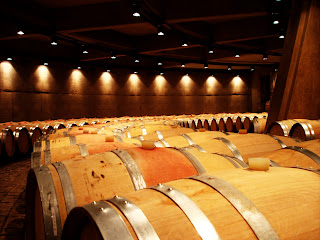 |
| Barrel room at Catena Zapata |
Just twelve miles south of the Mendoza city center, Lujan de Cuyo is home to some of the most successful wine-growing districts in the country. As Argentina's first official wine appellation, earning this status in 1993, the region now boasts a high concentration of vineyards and wineries of all sizes and styles.
From the large production wineries with towering estates and impressive architecture, to tiny family owned bodegas, to organic and biodynamic vineyards, the Lujan is a great place to explore the variety that Mendoza has to offer. The soil here is sand and stone above a layer of clay, the vineyards located at about 1,000 meters above sea level (about 3,000 feet) with the Rio Mendoza running straight through the region. All of these factors come together to make a great place to grow Malbec, Cabernet, and Syrah, with several other varietals showing potential as well.
 |
| Vineyards at Catena |
While recently touring the Lujan, our first stop was appropriately at one of the largest and most successful wineries in Argentina- Catena Zapata. First to introduce ultra-modern winemaking techniques and specialized vineyard practices, Nicolas Catena is responsible for gaining international recognition for Argentine wines, spearheading the future of Malbec in Argentina. With the first Malbec vineyard planted in 1902, the Catena family has been in the wine-making business for over 100 years.
After studying in California in the 1980's, Nicolas Catena returned to Argentina to experiment with different grape clones and vineyards planted at varying altitudes. His efforts resulted in high-caliber Malbec and Cabernet that would change the image of Argentine wine forever. Catena's wines were the first out of the country to compete on an international level with top wines from France, the U.S., and Italy, winning or coming in second place in blind tastings against the likes of highly-regarded Haut-Brion, Chateau Latour, and Opus One.
Catena has always focused on the power of assemblage- blending grapes from vineyards in different altitudes and microclimates to produce wines of depth, complexity, and balance. With vineyards in Agrelo, La Consulta, Tupungato, and Lunlunta, Catena can better control the character of the wines by choosing how much from which vineyards go into the blends. For instance, while Malbec from the Angelica vineyard in Lunlunta produces flavors of plum and red fruit with soft tannin, Malbec from the Altamira vineyard in La Consulta contributes black cherry and floral notes.
Since the 2001 launch of the winery's flagship wine, Nicolas Catena Zapata, Catena and the winery have achieved an amazing amount of international recognition. Nicolas Catena was named Decanter Man of the Year in 2009 and just this week in Catena Zapata was named New World Winery of the Year for 2010 by Wine Enthusiast Magazine in a ceremony in New York.
Nicolas Catena's daughter and winemaker, Laura Catena, also operates her own winery, Luca Wines, in the Uco Valley. She has gained a great deal of fame as a super-star female winemaker and recently authored Vino Argentino, a complete guide to Argentine wine.
 |
| Bodega Catena Zapata. And me, looking minuscule. |
Resembling a something like a fortress from a 1960's sci-fi film, Catena is one of the most visually interesting buildings to tour in the Lujan. Built in the shape of a pyramid, everything is made of stone and glass, the Andes mountains reflecting off of windows and doors. Follow the golden staircase in the center of the building to the roof where you can overlook miles of vineyards laid down before a mountain vista.
The tour concludes with a tasting of the 2007 Catena Malbec. It's super easy-drinking, with ripe cherry and raspberry fruits, a generous dose of oak and spice to finish. It's friendly, but surprisingly simplistic. At about $17 a bottle, it's not the best deal in this price range, the higher-end wines from Catena being a better value for the price.
Catena Zapata Lines
Argento and Malambo. Entry-level easy drinking, good quality for the price.
Los Alamos. International style, single-varietal wines. Everything from Malbec to Pinot Noir to Bubbly.
Saint Felicien. Catena's oldest line, a step up from Los Alamos. The first 100% single-varietal wine produced in Argentina.
DV Catena. Here's where the wines really start to impress. Single-varietals and blends assembled from vineyards at different altitudes and microclimates.
Angelica Zapata. Crafted with grapes sourced from high-altitude vineyards (3200-3900 ft a.s.l.), greater complexity of flavor and concentration in these wines. The Alta Malbec is particularly impressive.
Catena Zapata. Top of the line, limited production, highly acclaimed and consistently highly-rated wines. A collection of single-vineyard Malbecs. The best of Catena.
Nicolas Catena Zapata. The wine that changed the way the world thinks about Argentine wines. Only made in the best years.
Also check out Bodegas Caro, a partnership between Nicolas Catena and Lafite Rothschild of Bordeaux.



